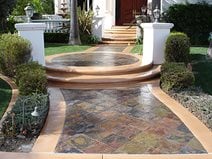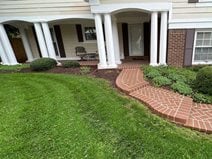- Concrete Walkways and Sidewalks
- Concrete Walkway Pictures
- Decorative Finishes for Existing Walkways
- Fix and Color Existing Concrete Walkways
- Sidewalk Repair - Resurfacing Concrete Walkways
- Design Ideas for Concrete Walkways
- 10 Ideas for Concrete Entryways
- Stairs and Steps
- Stamped Concrete Walkways
- Concrete Garden Bridges
- Front Porch Designs and Ideas
- Installing and Maintaining Concrete Walkways
- Concrete Walkway Cost
- Building Tips for Concrete Sidewalks & Walkways
- Sealing and Protecting Walkways & Sidewalks
- Sidewalk Pavers
- Other Resources
- Concrete Contractors: Find Products and Suppliers
DESIGN IDEAS FOR CURVED CONCRETE STEPS
Here are 11 ideas for creating concrete stairways with real curve appeal.Decorative concrete steps and stairways are great ways to give the entryway to a home more dramatic flair and curb appeal. In addition to their ability to be stamped, colored, and textured, concrete steps can also be cast in all sorts of curved configurations, allowing you to break away from the straight lines and boxy look of traditional stairways. By casting the concrete using flexible forms, almost any shape is possible, from sweeping curves to tight radiuses. Check out these stunning examples.
Find concrete contractors near me.
Liquid Stone Concrete Designs LLC in Warminster, PA
1. Concentric Circles
Even a small entryway can be made to look larger by casting a concrete stairway in concentric semi-circles, with the bottom circle extending beyond the door’s boundaries. This configuration also allows two or three visitors to approach the door from different angles without bumping into each other.
KB Concrete Staining and Polishing in Norco, CA
2. Soft Landing
Two half-round concrete steps soften the straight lines of a terraced landing, creating interesting contrast and a warmer, more inviting entrance. For cohesion, both the steps and landing were stained a sandy brown and textured with seamless texture skins.
Brickform, a division of Solomon Colors, Inc.
3. Curved Ascent
You can also put curves into the sides of a concrete stairway to create a spiral staircase effect. This is especially effective when the stairway must ascend a steep slope, eliminating sharp, angular turns. For safety, these steps were given a decorative spray-on texture to add traction.
Brickform, a division of Solomon Colors, Inc.
4. Bullnose Edges
A great way to accentuate the curves in a concrete step is to give it a cantilevered, bullnose edge. This is easily created by attaching a flexible polyurethane bullnose form liner to the inside of the step form. These liners come in both smooth and textured profiles, allowing you achieve a variety of looks.
Ozark Pattern Concrete, Inc. in Lowell, AR
5. Subtle Approach
Curves in concrete steps don’t have to be dramatic to create an impact. Even slight curvatures can make a concrete stairway more aesthetically pleasing by eliminating hard, sharp angles. They also are easier to form than tighter curves.
Goldenwest Epoxy in Costa Mesa, CA
6. Light the Way
To make a curved concrete stairway stand out after dark, consider casting built-in light fixtures in the step risers at the time of construction. In addition to adding beautiful nighttime ambiance, outdoor step lighting will also help prevent stumbles and potential injury.
Sundek Products USA, Inc. in Arlington, TX
7. Accent the Borders
Enhancing concrete steps visually with contrasting colors and patterns can also help to prevent missteps. The edges and vertical faces of this concrete stairway were colored brown and given a roughened stone-like texture, drawing attention to the curves while tying into the appearance of the natural stone columns flanking the front door.
Pac West Coatings in Carson, CA
8. Go Full Circle
This gorgeous stained concrete entryway features a circular landing between the front walkway and the curved concrete steps leading up to the doorway. Besides giving the walkway more character, this spot invites visitors to stop, walk around, and take in the surrounding scenery.
Coating Por Inc in Loomis, CA
9. Smooth Transition
At steep entryways, a decorative concrete sidewalk may require terraced steps to ease the transition from one elevation to another. The curves in the risers of these stained concrete steps echo the curves in the walkway, creating an unified appearance. Get more ideas for concrete entryways.
Brickform, a division of Solomon Colors, Inc.
10. S-Curves
For especially wide concrete stairways, casting the steps in serpentine s-curves instead of straight lines creates a nice flow from one end to the other while adding architectural appeal. This free-form look works best in informal settings, such as a backyard porch or patio.
Sundek Products USA, Inc. in Arlington, TX
11. Pattern Play
This curved concrete stairway and front porch feature a decorative overlay in a herringbone brick pattern, creating an eye-catching zig-zag effect. Resurfacing an existing concrete stairway or patio with an overlay allows you to completely transform its appearance by offering a wide array of pattern, color, and texture options.
WHAT ARE THE BEST MATERIALS FOR FORMING CURVED CONCRETE STEPS?
There are several forming options to choose from when pouring curved concrete steps. Here are three of the most common, along with some of the pros and cons of each.
- Wood: This is the most basic forming material for concrete steps and the least expensive. Thinner plywood panels can easily be bent to create custom curved forms, but they generally don’t have enough flexibility to create tight curves. You can also use standard 2x4s and cut kerfs, or notches, into them to allow the wood to bend.
- Plastic: Flexible plastic forms have several benefits over plywood, including providing multiple reuses as well as being extremely pliable when a tight radius is needed. They can be secured to traditional wood or metal form stakes and come in various heights. Another plus: Concrete doesn’t stick to them, allowing for quick removal.
- Metal: This is the sturdiest and longest-lasting forming material for concrete steps and other flatwork, and typically the most expensive. Radiused metal step forms, such as the EZ-Step System, are quick and easy to assemble and come with pre-attached rubber liners.
Tip: No matter what type of step forming system you are using, make sure to brace the forms well to keep them from bowing. Fresh concrete is heavy and can easily push the forms outward if they aren’t secure, ruining your perfect curves.
Learn more about concrete step forms and form liners.
RELATED:
How to Pour Concrete Steps
Concrete Step Design
Circular Concrete Patios















